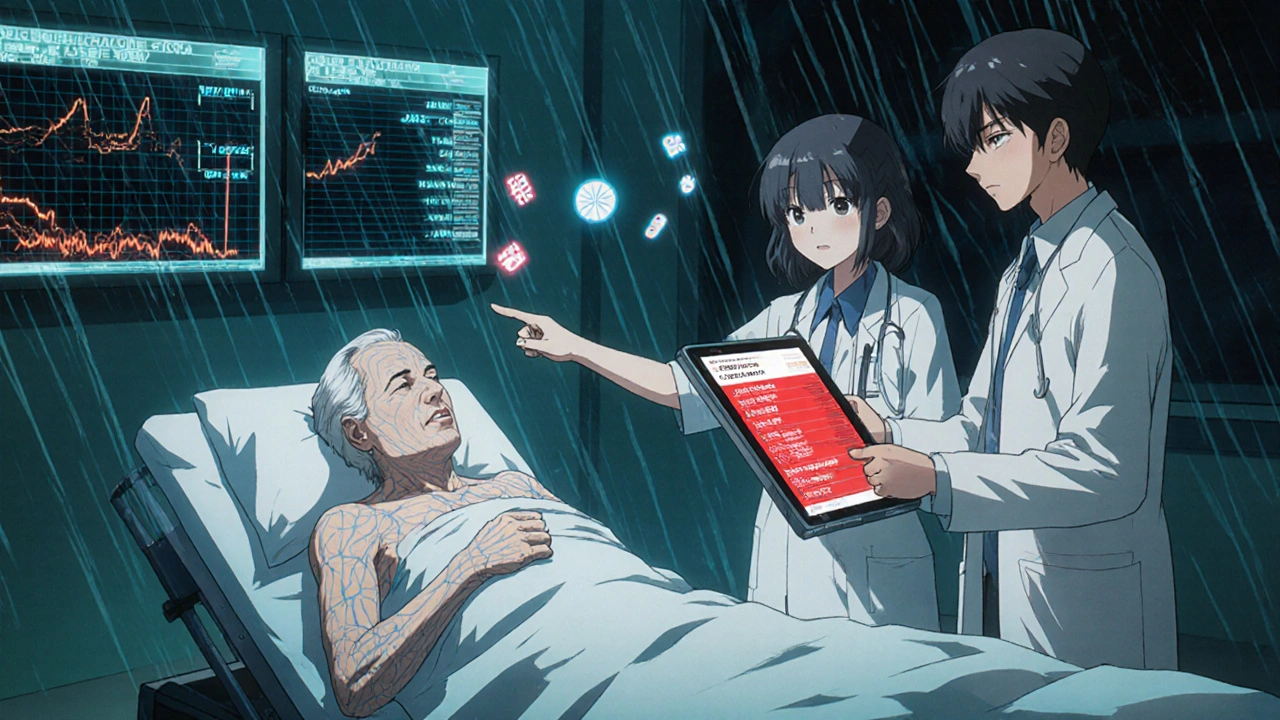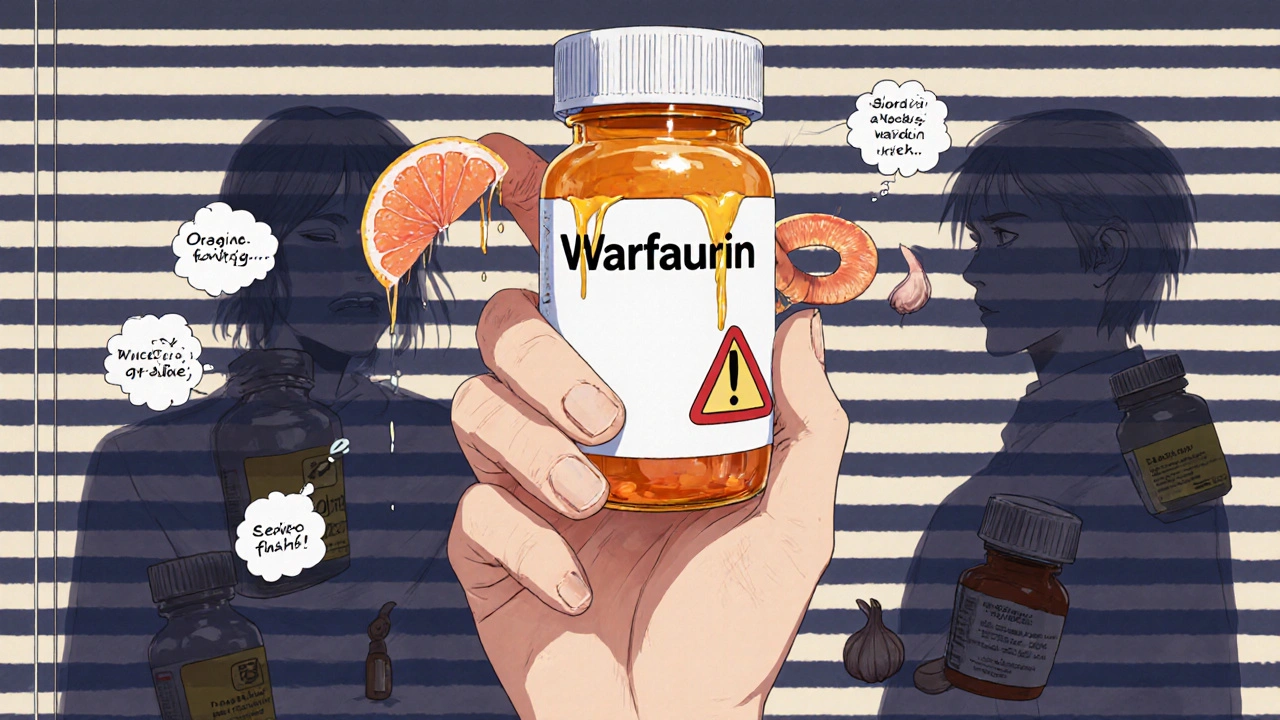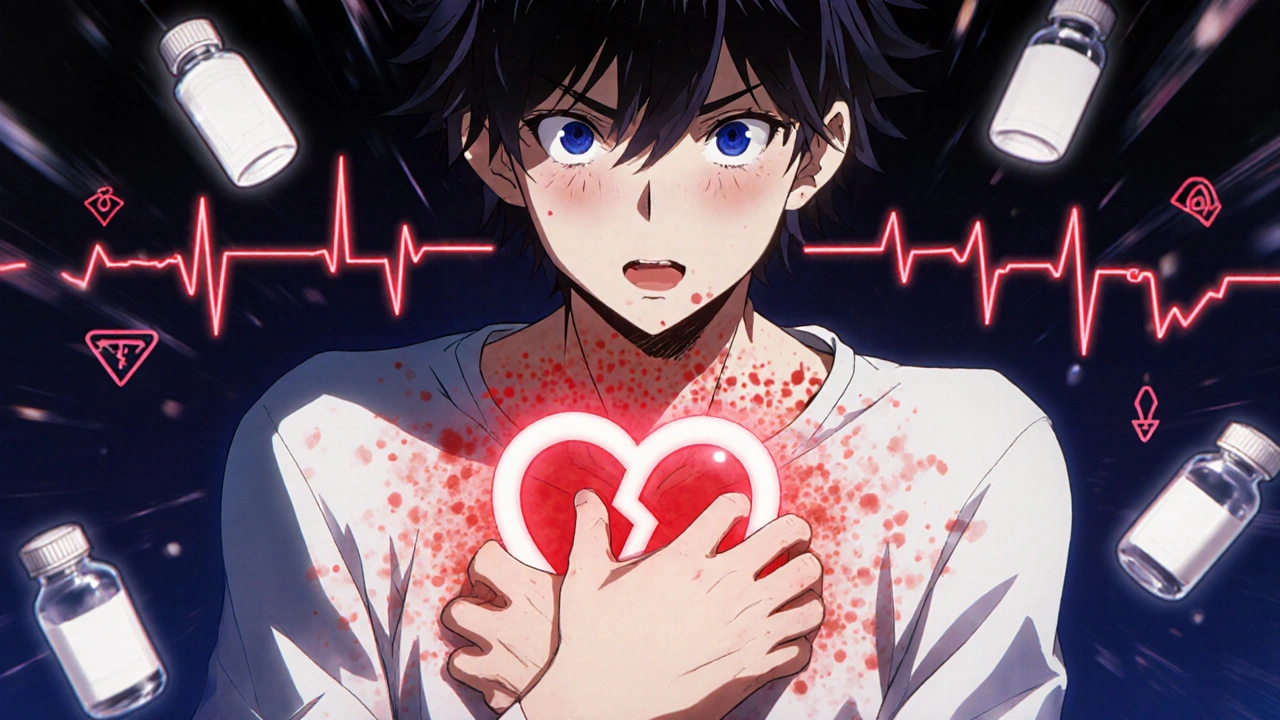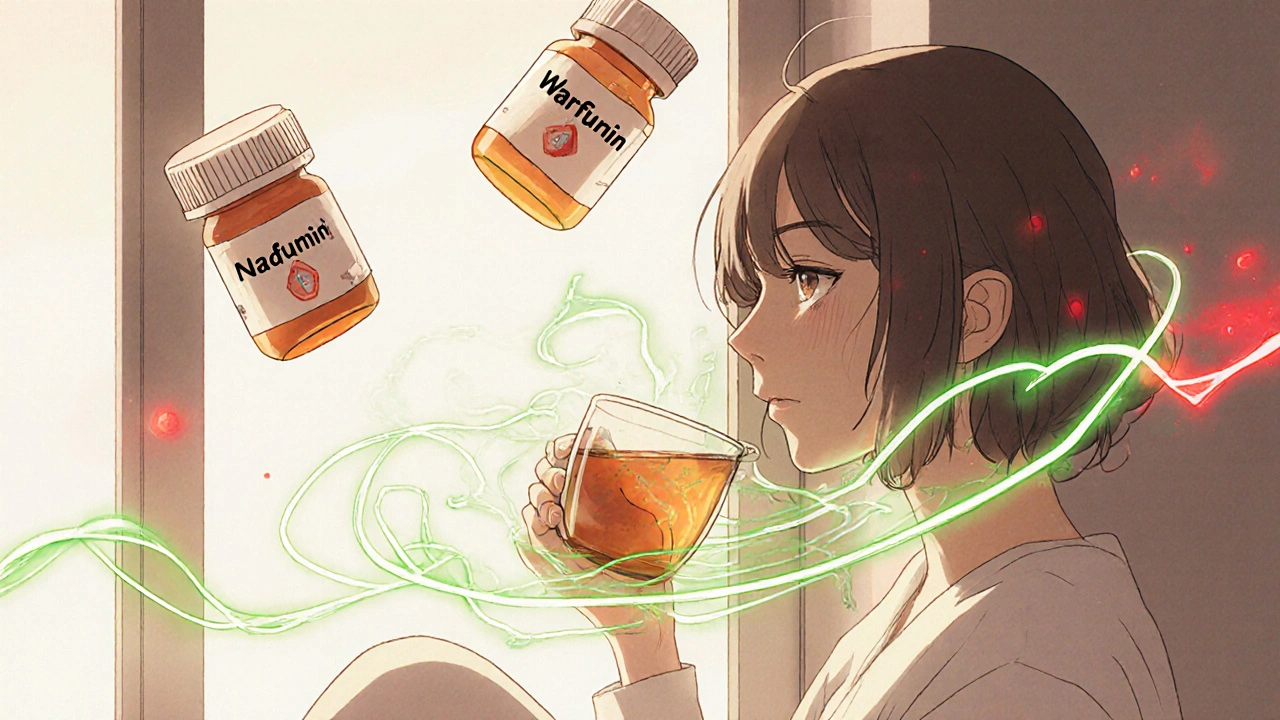You’re taking your meds like you’re supposed to - morning pill, evening pill, maybe a supplement or two. But now you feel off. Dizzy. Nauseous. Your skin is breaking out in a rash. Or worse - you can’t breathe. Is this just a bad day, or is it something serious? Drug interaction symptoms can be sneaky. They don’t always show up right away, and they often look like something else. The problem? Waiting too long can turn a manageable issue into a life-threatening emergency.
What Counts as a Dangerous Drug Interaction?
A drug interaction happens when one substance changes how another works in your body. It could be two prescription drugs, a prescription and an over-the-counter medicine, or even a medication and something you eat, drink, or take as a supplement. These aren’t rare. About 60% of serious interactions happen between two drugs. Another 20% involve food or drinks, and the rest are tied to existing health conditions. Some interactions are mild - maybe you feel a little more tired than usual. Others? They can shut down your liver, stop your kidneys from working, or send your heart into chaos. The real danger lies in the fact that many people don’t recognize the signs until it’s too late. According to the CDC, drug interactions send 1.3 million people to the ER every year in the U.S. - and 350,000 of them end up hospitalized.Call 911 Right Now If You Have These Symptoms
Some reactions don’t wait. If you’re experiencing any of these, don’t call your doctor. Don’t wait until morning. Call 911 immediately.- Difficulty breathing or oxygen levels below 90% - This isn’t just being winded. If you’re struggling to get air, your body is in crisis. Pulse oximeters show this clearly, but even without one, if you’re gasping or your lips are turning blue, act now.
- Swelling of the face, lips, tongue, or throat - This is angioedema. It can block your airway in under 20 minutes. I’ve seen cases where someone took a new antibiotic and woke up with a swollen tongue - by the time they got to the car, they couldn’t speak.
- Fast heartbeat (over 120 bpm) with low blood pressure (below 90 mmHg) - This is anaphylactic shock. Your body is going into full alarm mode. It’s not anxiety. It’s a medical emergency.
- Seizures lasting more than 2 minutes - If you or someone else is convulsing and doesn’t stop, this could be drug toxicity. Lidocaine, certain antidepressants, and even some antibiotics can trigger this in rare cases.
- High fever (above 106°F), rigid muscles, and extreme agitation - This is serotonin syndrome. It happens when too many drugs boost serotonin - like mixing SSRIs with migraine meds, painkillers, or even St. John’s wort. Patients often describe it as feeling like they’re “on fire inside.”
- High fever (above 104°F), dark urine, and muscle pain - This could be neuroleptic malignant syndrome, a rare but deadly reaction to antipsychotics. Creatine kinase levels can spike above 10,000 U/L - that’s 10 times normal.
See a Doctor Within 24 Hours If You Notice These Signs
These symptoms aren’t always emergencies - but they’re red flags that shouldn’t be ignored. Waiting longer than a day can let things spiral.- A rash covering more than 30% of your body - This isn’t just a minor breakout. It could be DRESS syndrome - a severe reaction that attacks your organs. It often starts with a red, flat rash that turns into blisters. It’s linked to anticonvulsants, antibiotics, and allopurinol.
- Unexplained fever over 101.3°F for more than 48 hours - If you’ve started a new medication and now have a persistent fever, it’s not a cold. It could be serum sickness or another immune reaction.
- Unusual bruising, bleeding gums, or nosebleeds - A platelet count below 100,000/μL means your blood can’t clot properly. This can happen with antibiotics like vancomycin or chemotherapy drugs.
- Yellow skin or eyes, dark urine, or right-side abdominal pain - These are signs of liver damage. ALT levels above 120 U/L are a red flag. Drug-induced liver injury is often silent until it’s advanced.
- Less than half a cup of urine in six hours, or rising creatinine - Your kidneys might be shutting down. This happens with NSAIDs, certain blood pressure meds, or contrast dyes. It’s more common in older adults or people with existing kidney issues.

What Makes an Interaction More Dangerous?
Not all drugs are created equal. Some are like fine-tuned instruments - even a tiny change can break them. Drugs with a narrow therapeutic index are the most dangerous. That means the difference between a helpful dose and a toxic one is tiny. Examples:- Warfarin - A blood thinner. A single interaction with antibiotics or even grapefruit juice can send your INR soaring and cause internal bleeding.
- Digoxin - Used for heart rhythm. Too much and your heart can stop. Too little and it doesn’t work.
- Phenytoin - An anti-seizure drug. A 20% change in blood levels can trigger seizures or cause brain toxicity.
Why People Wait Too Long (And What Happens When They Do)
Most people don’t realize they’re having a drug interaction until it’s bad. A 2023 survey found that 72% of patients who ended up in the ER had ignored early symptoms like dizziness, nausea, or fatigue. They thought, “It’ll pass.” One Reddit user shared how they took an SSRI and then got fentanyl for a dental procedure. Within hours, they started clonus (involuntary muscle jerking), sweating, and shaking. They waited 10 hours before calling their doctor. By then, they were in the ICU. 41% of similar cases in online forums required intensive care. On the flip side, people who called poison control within an hour of noticing symptoms were 89% more likely to avoid the ER entirely. Poison control centers aren’t just for overdoses - they’re your first line of defense for interactions. They can tell you whether to wait, monitor, or rush to the hospital.
What You Can Do Right Now
You don’t have to wait until something goes wrong. Here’s how to stay safe:- Keep a full list of everything you take - Not just prescriptions. Include vitamins, supplements, herbal teas, and even OTC painkillers. Many serious interactions come from “natural” products like St. John’s wort, garlic pills, or kava.
- Use a trusted interaction checker - Drugs.com and Lexicomp are updated daily and screen over 24,000 medications. Input every substance you’re using - even if you think it’s harmless.
- Ask your pharmacist every time you get a new prescription - They’re trained to spot interactions. Don’t assume your doctor knows about every supplement you take.
- Learn the STOP protocol - If you suspect an interaction: Stop the medication, Telephone your provider, Observe symptoms, Present all your medication bottles at the appointment.
Final Thought: Don’t Guess. Act.
Medications save lives - but they can also hurt you if you don’t know the risks. The good news? Most serious interactions are preventable. You don’t need to be a doctor to spot danger. You just need to listen to your body. If something feels wrong - and it’s new, unusual, or getting worse - don’t wait. Don’t rationalize it. Don’t hope it goes away. Call your doctor. Call poison control. Go to the ER. It’s better to be safe than sorry.Can over-the-counter medications cause dangerous drug interactions?
Yes. Many people assume OTC drugs are harmless, but that’s not true. Ibuprofen can increase bleeding risk when taken with warfarin. Antihistamines like diphenhydramine can cause confusion in older adults on other sedatives. Even common supplements like St. John’s wort can reduce the effectiveness of birth control pills, antidepressants, and heart medications. Always check interactions before taking anything new - even if it’s sold without a prescription.
How long does it take for a drug interaction to show up?
It varies. Some reactions happen within minutes - like an allergic response to penicillin. Others build slowly over days or weeks. Liver damage from acetaminophen or antibiotics might not show symptoms until the organ is already injured. If you start a new medication and feel off after 2-3 days, it’s worth investigating. Don’t assume it’s just a side effect - it could be an interaction.
Can food and drinks cause drug interactions?
Absolutely. Grapefruit juice is the most well-known - it can make blood pressure, cholesterol, and anti-anxiety meds too strong, sometimes to dangerous levels. Alcohol can worsen drowsiness from opioids or benzodiazepines. Dairy can block absorption of antibiotics like tetracycline. Even high-sodium foods can interfere with blood pressure meds. Always read the label or ask your pharmacist about food interactions.
Are older adults at higher risk for drug interactions?
Yes. About 45% of adults over 65 take five or more medications daily. That increases the chance of interaction to 57%. Older bodies also process drugs slower, so even normal doses can build up. Kidney and liver function decline with age, making it harder to clear toxins. Many seniors take supplements too - which adds another layer of risk. Regular medication reviews with a pharmacist are essential for this group.
What should I bring to the doctor if I suspect a drug interaction?
Bring every pill bottle - prescriptions, OTC meds, vitamins, herbs, and supplements. Don’t rely on memory. Include dosages and how often you take them. If you’ve kept a symptom journal - when symptoms started, what you ate, what meds you took - bring that too. Photos of rashes or videos of unusual movements (like tremors or jerking) can help doctors diagnose faster. The more detail you give, the better they can help.
Can drug interactions be reversed?
Sometimes, yes. Stopping the offending drug (called dechallenge) often leads to symptom improvement within hours or days. For severe cases like serotonin syndrome, doctors may give medications to block excess serotonin. In liver or kidney damage, treatment focuses on supporting organ function while the body clears the drug. But not all damage is reversible - especially if it’s delayed. Early action is the best way to prevent lasting harm.
Is it safe to use online drug interaction checkers?
Yes - but use them wisely. Tools like Drugs.com, Lexicomp, and Micromedex are reliable and updated daily. They’re great for screening. But they’re not a substitute for professional advice. If a checker flags an interaction, don’t panic - but don’t ignore it either. Call your pharmacist or doctor. They can tell you if the risk is real, how serious it is, and whether you need to change anything.
How do I know if my symptoms are from the drug or something else?
Look at timing. Did the symptom start within hours or days of taking a new medication or changing a dose? Did it get worse when you added another drug? Did it improve after stopping the medication? That’s the pattern of a drug interaction. If you feel fine for weeks, then suddenly get sick - it’s less likely to be drug-related. Still, if you’re unsure, it’s better to get checked. Your doctor can run blood tests or check levels to confirm.


